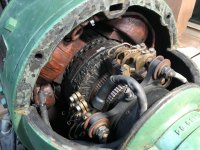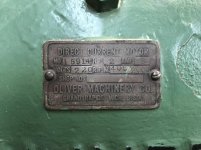I recently purchased an Oliver No. 25 pattern makers lathe with the original direct drive DC 2hp Motor. The lathe was manufactured in 1914. The motor is integral to the machine so can't be replaced with a modern motor. I included some photos. It has a modern variable speed motor control. The motor is rated from 400-2000 rpm.
It runs but as the speed is increased,the brushes arch severely at the commutator, it also does not have the power it should have. I currently have it at a motor shop which was recommended to me. They have checked everything, grounds etc. They checked the drive and ran the lathe direct from line DC. They turned the commutator and seated the brushes this didn't help, nothing has helped. They partially unwrapped one of the interpoles and a field coil and the wire insulation is breaking down and can be scrapped of with a fingernail, so their next step would be to rewind the two fields and the four interpoles. The shop wants $1500 to rewind the six coils, plus $500 for the comm turning, testing and reassembly, "about" $2000 total. If this does not work, they would send the armature out to be rewound. The shop they would send it to is reluctant to even do it because they claim if it needs a new commutator, it alone would have be custom made by a shop in Europe costing at least 2k, then the armature rewinding.... I am already in deep, including lugging this 3000# 12' lathe to the very back of my shop. Help!
Any thoughts regarding the estimates (seems high?) or any suggestions(except for scraping)would be much appreciated. Thanks in advance!




It runs but as the speed is increased,the brushes arch severely at the commutator, it also does not have the power it should have. I currently have it at a motor shop which was recommended to me. They have checked everything, grounds etc. They checked the drive and ran the lathe direct from line DC. They turned the commutator and seated the brushes this didn't help, nothing has helped. They partially unwrapped one of the interpoles and a field coil and the wire insulation is breaking down and can be scrapped of with a fingernail, so their next step would be to rewind the two fields and the four interpoles. The shop wants $1500 to rewind the six coils, plus $500 for the comm turning, testing and reassembly, "about" $2000 total. If this does not work, they would send the armature out to be rewound. The shop they would send it to is reluctant to even do it because they claim if it needs a new commutator, it alone would have be custom made by a shop in Europe costing at least 2k, then the armature rewinding.... I am already in deep, including lugging this 3000# 12' lathe to the very back of my shop. Help!
Any thoughts regarding the estimates (seems high?) or any suggestions(except for scraping)would be much appreciated. Thanks in advance!





